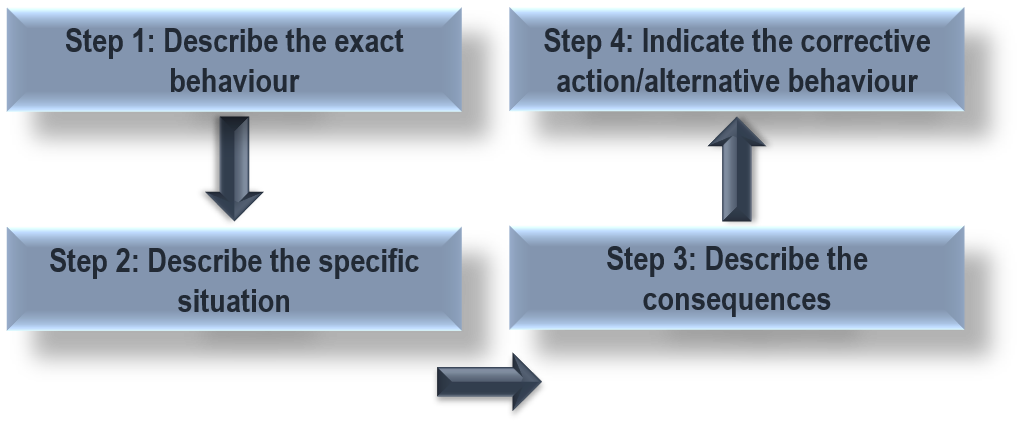Paul J Jerome, in his book “Coaching through effective feedback”, shares a model that can apply effectively to give positive feedback, negative feedback, and neutral feedback, in a constructive manner.

Step 1: Describe the Current Behaviour: Describe the current behaviour that you want to reinforce or redirect to improve the situation or the performance of the individual. Be specific. Focus on behaviour and not personality, attitude, or characteristics.
Step 2: Identify the Situation: Show the specific situation where you saw this behaviour. Be factual, give date and time, if needed, or describe the event.
Step 3: Describe the Impact of the Consequences of the Behaviour: Describe the impact or consequences of the behaviour to the person. Be precise and objective.
Step 4: Identify Alternative Behaviour/Corrective Action: Discuss alternative behaviour that the person can consider for future purposes. Also, consider what corrective action could rectify or improve the current situation/consequences.
Include the consequences for the business/job/organization as well as the consequences for the individual/person.
|
1. DESCRIBE CURRENT BEHAVIOURS |
4. IDENTIFY ALTERNATIVE BEHAVIOURS |
|
Bonnie. I would like to discuss with you how you have showed judgment. initiative and independence on the job over the last year: Specifically: You distinguish between when you can handle a situation and when you need help. You initiate your own goals. plans. schedules and work efforts with little to no direction or supervision. |
How can I "open new doors of opportunity" for you? Would you like more visibility with customers and/or senior management, challenges, autonomy, leadership opportunities, etc. If not, that is OK! You will still have our appreciation! How can we reward your efforts with that which motivates you and is within our control (e.g. verbal, and written praise?) |
|
2. IDENTIFY SITUATIONS |
3. DESCRIBE IMPACTS AND CONSEQUENCES |
|
A. On Project 'ABC’ you accurately identified technical errors in a briefing and corrected it with an immediate and appropriate memo direct to the source. On project "XYZ". you sensed there was a technical error but were not sure, so you checked with me first. B. You initiated a complex system reengineering effort required in one year, from project scoping through scheduling and completion, all with little need for assistance. C. On xx/xx/xx and xx/xx/xx you independently met with senior manager, Rock Gibraltar, identified and discussed issues on Project ‘XYZ’, drafted plans and recommendations and reviewed the drafts with me and others to gather additional ideas before responding. |
Your efforts are perceived as "value-adding" by our customers, senior management, our team, and me. I can assign you to any project with complete confidence; you are a project leader with sound judgment. You will have more say about which projects you receive. If possible, you may choose some yourself. You are highly trusted with the customer and by the customer. Your credibility is well-established. Your ideas are listened to and your recommendations are acted upon. You save me tremendous time. You may continue to work autonomously. You reduce risks. You know what you do not know. Therefore, I can put you in charge of "grey" or "risky" assignments and not worry about your performance. You will ask for help when you need it. |